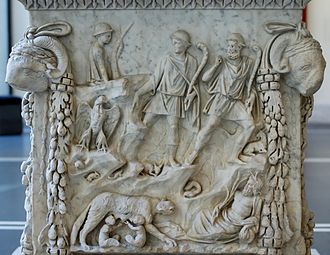
Back Ficus Ruminalis AN فيكس روميناليس Arabic Ficus Ruminalis Catalan Ficus Ruminalis German Ficus Ruminalis Spanish Ficus Ruminalis French Fico ruminale Italian Ficus Ruminalis Latin Figueira Ruminal Portuguese Руминальская смоковница Russian


The Ficus Ruminalis was a wild fig tree that had religious and mythological significance in ancient Rome. It stood near the small cave known as the Lupercal at the foot of the Palatine Hill and was the spot where according to tradition the floating makeshift cradle of Romulus and Remus landed on the banks of the Tiber. There they were nurtured by the she-wolf and discovered by Faustulus.[1][2] The tree was sacred to Rumina, one of the birth and childhood deities, who protected breastfeeding in humans and animals.[3] St. Augustine mentions a Jupiter Ruminus.[4]
- ^ Livy, I.4
- ^ Varro, De lingua latina 5.54; Pliny, Natural History 15.77; Plutarch, Life of Romulus 4.1; Servius, note to Aeneid 8.90; Festus 332–333 (edition of Lindsay).
- ^ Lawrence Richardson, A New Topographical Dictionary of Ancient Rome (Johns Hopkins University Press, 1992), p. 151.
- ^ Augustine, De Civitate Dei 7.11, as cited by Arthur Bernard Cook, "The European Sky-God, III: The Italians," Folklore 16.3 (1905), p. 301.
© MMXXIII Rich X Search. We shall prevail. All rights reserved. Rich X Search